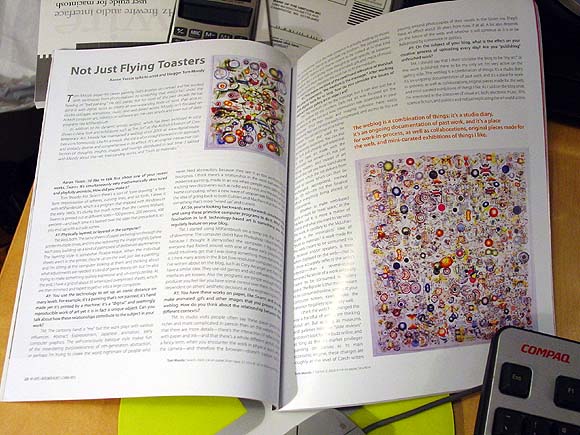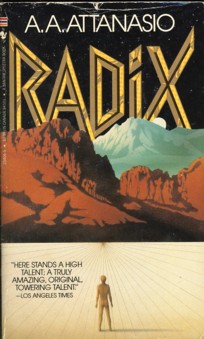View current page
...more recent posts
 An excerpt from the interview Cory Arcangel did with me at Rhizome.org [dead link - see below]:
An excerpt from the interview Cory Arcangel did with me at Rhizome.org [dead link - see below]: "The computer still has the shock of the new, or the shock of the bad in some cases. Art world folks know painting, photo, and printmaking lore, but are less secure--myself included--knowing what constitutes talent on the computer as opposed to some easy-to-do technical trick. I thought because everyone had Paint or the equivalent on their computer and had at least made a mark or spritzed the spraycan, they could see that I was doing something more ambitious with it. I was thinking of this guy in New Mexico who made perfect perspective drawings using an Etch a Sketch. If I could draw La Femme Nikita from scratch on this toy program and actually have people (well, guys) say she's hot, then a landmark would be achieved for both Paintbrush and the computer. The problem is I drew her so realistically people assumed I was running a photo though a pixelating filter.
"When I talk about craft on the blog, just to make it clear, I'm not talking about drawing ability but things like mosaics and needlepoints that relate to the computer on a much more fundamental image-making level, the grid level. I love the cross-stitch patterns and beadwork you can find online based on MSPaint drawings. In the late '90s I was impressed by the writing of cyberfeminist Sadie Plant, who opened up for me a whole organic, non-analytical way of looking at computation. She traces digital equipment back to one of its earliest uses, as punchcards for looms, and talks of the internet as a distributed collaborative artwork akin to traditionally feminine craft projects At the time I was drawing and printing hundreds of spheres at work and bringing them home, cutting polygons around them, and then taping the polygons back together in enormous paper quilts. In my press release for the Derek Eller show we called it 'corporate tramp art.'"
Update: New Link to Cory's interview with me.
Continuing my unbirthday celebration, this image arrived by email, with the caption INVINCIBLE. Another gem. Thanks to Diana and Matthew, and Luke for the badass figure.

"Permanent Chase" [mp3 removed]. The second in a projected series of "quieter" pieces for drum machine and Sidstation. The first was "Clip City" [mp3 removed]. They're not really quieter, they're just not as compressed as my other audio so they don't explode out of a pair of computer speakers. Bump the volume a bit and they're "loud enough." [Update: I've since made both of these tracks louder; these are the quiet versions.]
On "P. C.," yes, the lead is repetitive and dumb. It's supposed to be kind of a joke. And the key change at the end is also a bit of a joke after all the repetition (bad musicians use gratuitous key changes to hide a thin song). For those who might think I use only presets and dry, out of the package synth sounds, generally I like'em but these pieces actually got a fair amount of tweaking. As I explained in an earlier comment:
I've been using controllers (knobs and curves) in a lot of the work. Mostly cutoff filter/resonance, some LFO vibrato and sweeps. In "Permanent Chase" I used a controller to detune one oscillator, that's how I did my "key change." The drums in "Clip City" were filtered using LFO to change the envelopes, and "Permanent Chase" had three 45-second "movements" each using its own distinct filter settings (the Mutator effects filter in two of them plus Spektral Delay in the third). Each part was mixed down separately, run through noise reduction then cross faded so it appeared to morph out of the one that preceded it. This was all in the drums. The Sid had chorus plus the detuning. Maybe I should be proud that everything still sounds "out of the box."
My birthday falls, um, around Halloween (we ain't all sentimental on this blog so that's all I'm sayin'). Stephen and Andrea carved a pumpkin in my honor and named it Tom. Thanks, guys, it's beautiful.

I've been having an interesting discussion offline about the "confusing" nature of my recent music. A listener suggested that if it's German trance or house I'm going for, it should be more sophisticated and varied, with more filtering, pitch-shifting, layering of sound, use of quantizing to give more swing to the rhythm, and less use of factory presets. If it's conceptual art (as in Yoko Ono or Philip Glass minimalism--my examples), it should be a lot clearer that's the frame of reference. As it is, the listener says, the music is somewhere in the middle and needs to lean one way or another.
Maybe what set him off was a piece I just posted, called "Permanent Chase," which took a one bar "found" melody and pretty much beat it to death. Composing for me isn't about spending hours in the lab creating new synth sounds--it's more about taking what's there and using it to just to the point where you're about to scream and then tossing in one little change that brings some closure. Maybe with that piece I failed (too many bars before the goofy key change? maybe if snipped out about 8-16 bars?). I've pulled it pending further study 'cause I'm not sure myself.
Generally speaking, though, I like that middle ground he's talking about. My visual work has always occupied a realm somewhere between "failed commercial art" and "conceptualism that's too stupid to look at." I certainly started out doing music with that mindset. I've been grinding out so much of it lately that maybe it's starting to get "good," as in, one wants to hear it be "better." That may be the time to walk away from it. My hearing would probably thank me.
Steve Gilliard wrote this imagined dialogue between Bush Senior (41st president) and Junior (illegitimately elected 43rd). The substance is there, but this conversation would never occur in a patrician family like the Bushes'. 41 would communicate his concerns to Barbara or one of Bush's brothers, who would pass it along to Junior. An even more likely scenario is that Senior would weakly, passively say nothing and Barbara (possibly after a few cocktails) would instigate and deliver the lines below:
The Bush family is sitting in the White House family quarters.
41 is standing, 43, sullen and silent while Barbara looks on
41: Son, you're in real trouble now
43: Whatever
41: No, son. You're in this up to your ass and I cannot fix it. I thought Dick would look out for you, but his ass is cooked as well.
43: I'll handle it.
41: Handle what? What are you going to handle? A prosecutor?
43: I'll pardon them
41: No you won't. You wanna be impeached like Clinton? People don't like you, George. You're mean and crude and this day has been coming for years.
[etc]
Cory Arcangel did an interview with me, published today at Rhizome.org [dead link - see below]. Thanks to him for the good back-and-forth, once I got my rather long-winded biographical reminiscing out of the way, and Marisa Olson for her editing. (Update: Marisa just reposted the lead-in to the interview--newsGRIST's reblogging of Rhizome's original post.)*
It was great to talk about music with Cory, whose work I really like. The 8-Bit Construction Set LP--which he made with the BEIGE crew--still gets props, most recently in an article in Wired. Also "Rudy Tardy and the Slowes," his solo music that I posted here a while back, continues to be listened and linked to, just this month by an Italian site called neural.it. We also talked about visual art--Chris Ashley found a good excerpt that I will probably post as a teaser; see the comments for now. In fact, I'll probably end up putting up goodly chunks of the interview here as I continue to have second thoughts and/or run out of new things to say.
At the end of the interview we discussed what it means for an artist to be "all over the place," i. e., not just sitting in the studio turning out objects in that same signature style. I gave the best answer I could--it's tough. I understand the benefits of that kind of forced discipline, and go in and out of periods of Tim Hawkinson-like focus myself, but I hate that it's the only measure of commitment or worth as an artist. One hope I had in starting the blog was that the various diverse activities documented here could be seen as feeding into some kind of overall artistic sensibility. But for all the lip service paid to the idea of cross-disciplinary practice by curators, etc., it's still viewed with skepticism. In the art world's collective unconscious, the prime model is still a romantic primitive like Albert Pinkham Ryder, painting all day and sleeping on the streets at night in a rolled up carpet. And doing nothing else.
reposted with more verbiage...and ranting
Update: New Link to Cory's interview with me.
*Update 2: Marisa Olson's lead-in is now at http://rhizome.org/editorial/2005/oct/31/tom-moody-chats-w-cory-arcangel/
Digital Media Tree blogger Jim Louis returned to his house in New Orleans, in one of the neighborhoods not smiled upon by the gods in the recent weather disaster, and has this report. Jim has been living in another state but still owns property in the city; he went back to assess the damage and is there now with his laptop. In a related post he said the water level on his block came to four feet, which is just slightly higher than his floor. My thoughts are with Jim as he surveys the damage in a city he has been reporting to us on for years.
Shoutback Dept., No. 1. Thanks to Marius Watz for his nice post on the Generator.x blog, published in connection with a conference and exhibition in Oslo examining the current role of software and generative strategies in art and design. Check out some of Marius' interactive abstractions here; they are seductive to look at, fun, and actually use the computer's image-making capabilities in way that lets the machine do some of the thinking, as opposed to my low-tech simulacra.
Shoutback Dept., No 2. Thanks to Ran Prieur for seconding my complaint about the Carter "energy sweater" urban myth, which holds that "Nerdy Jimmy Carter Wore a Sweater When Talking About Energy." This is wrong. To reiterate: Carter wore the sweater on many occasions after the '76 election, it was part of his laid-back "man of the people" persona, post-Nixon and his foppish uniforms for White House guards. Yet for some reason, media mavens of the left and right and even bloggers continue to enliven their prose with the image of the "nerdy energy sweater."
I've been enjoying Ran's site, which has many interesting things to say about dropping out and living off the grid that I hope to respond to in the coming weeks. Here's a pearl from his blog:
Notice that every article about energy systems contains the word "needs." How much energy do we need? Our ancestors did fine for two million years, or two hundred million if you count our pre-human ancestors, with energy gathered by plants through photosynthesis, taken into our bodies through eating, and channeled through our muscles. Do industrial energy systems make us happy? Do they give our lives meaning? Then why are suicide and depression rates higher in countries with greater per-capita energy consumption?
The only thing we need, beyond basic survival, is participation in a system that builds itself bottom-up from autonomous action. "Energy" makes us miserable and stupid when and only when it is gathered and parceled out by control systems. The nice thing about oil and coal is that they run out, and that they pollute the air to cause eco-catastrophes, which are far preferable to having our lives managed by the institutions that own the energy. Sustainable, clean energy that you can't cheaply gather in your back yard is the worst technology possible, because it will enable the systems that enslave us to continue forever.
I think behind human history is an evil collective consciousness that wants to crush the spirit of life, and techies are unwittingly resonating with it. After they take care of energy, they'll invent a way to make us immortal, so we can't even get out by suicide. We will become eternal torture victims of the megamachine, just like in Harlan Ellison's classic sci-fi story "I Have No Mouth And I Must Scream."

Jerry Saltz reviews Ludwig Schwarz's New York debut, sort of, in this week's Village Voice. Readers of this blog may have some passing familiarity with Schwarz from posts about him over the last couple of years (here, here and here), and from the "art is for the people" link that used to be on the left hand column (the site is gone and much missed; all that remains is the "brief history of texas blues"). Saltz misspells Schwarz's name and makes a dig that the work is "a little familiar in its funkiness" without explaining who else is similarly funky, but a review is a review. In fact, there's not much substance to the piece--the reader doesn't know what "jobbed-out paintings and tricked-out videos" means unless you google and end up, say, here (hard with the artist's name misspelled) and even then you won't learn what Saltz means by "tricked out." Did Schwarz cover TVs with sequins and feathers? (Obviously I missed the show's one day run.)

I'm burning up the mp3 charts at 397. Let's see, Bon Jovi, Coldplay, Scorpions, Kanye West, Christina Aguilera, House Classics for Solo Organ... D'oh, think maybe I better start putting my name on my .mp3 files, now that I'm getting traffic from download sites I didn't know about.
"Something Clicked (Reaktor)" [mp3 removed]. This is an older tune reworked with Reaktor synths. An almost gentle calypsoid techno becomes very...obdurate. Originally written in a notation software program, which is where the screen shot below came from. A couple of people said they thought my music had evolved. I think it only got louder (see comments to previous post).

"Clip City" [mp3 removed] (reposted). Been massaging this tune, which was a crackly mess when it first appeared. I love the analog drum machine sound, but discovered the kicks and toms are so full-bodied digital audio won't capture them unless the gain is turned way down for the recording input. Sometimes you can raise it again in the mix but that's not working here. Nothing's lost in the final version, it just means the .mp3 is quieter and you'd have to bump the volume on your player to hear it at its best. I think some versions of iTunes adjust volume so all loaded tracks sound the same.
All the sequencing in this song I did, in other words, no found or cut-and-pasted MIDI. I know the lead line is ridiculous but sometimes I just rebel at doing a lot of musician-like variations in the melody. Octave jumps, that's all you get. The filtering is also all analog. It's kind of a prototype. I have this idea of doing a suite of 10 songs for the drum machine and Sidstation, which could be performed pretty easily live. I'm kind of bummed I can't get louder recording, though. Also, after I finished the tune I realized it sounds like Antonelli Electr. Oh well, if you're going to imitate people it might as well be your gods.

Thor Johnson sent this mashup of the OptiDisc GIFs posted earlier. Thanks! It looks like a 3-D image before you put the glasses on. Just saw the DVD prototype of this GIF and am pleased by how it came out--very minimal, clean and dumb. On a 20 inch Sony screen, it's everything I wish TV was. No Bill O'Reilly, no Tim Russert, just a cheap but elegant hypnodisc. It loops
One of the funniest things I've seen is Dave Chappelle's routine about the bus held hostage by a masturbating homeless man. Chappelle imitates a passenger flinching and shrieking "Biological Attack!" Then he describes the homeless man walking up and down the aisle, stroking himself and saying "OK, who wants some?" while riders sit there helpless with fear. Finally a burly man at the back of the bus says, "Let's rush him! He can't hit all of us!" The attacker is subdued, but not before a man gets a "nut busted" on his balding forehead. "Can't I get AIDS from this?" the man wails. "Of course not," says Chappelle, but then admits to the audience he has no idea and just said it to make the guy feel better.
As long as we're posting animations too large or silly for the blog, here's one called Atom Kitty, or, The Philosopher.
"Clip City" [mp3 removed]. This analog drum machine (the blue thing below) is so punchy puffs of air come from the speaker; unfortunately I have no digital recorder that will capture the full bass. So I went for a gritty "I did it at home" sound--lots of hiss, hum, and clipping, hence the title. This has a slightly menacing mood, at least until the Sidstation comes in. [Update--the tune has been re-recorded and reposted. I made separate tracks and subtracted "clipboard noise" on each one--what a concept--and then remixed it, eliminating most of the extraneous noise and eponymous clipping, except for a few bad patches. I also softened the Sid.] [Update 2: re-recorded again, and this time eliminated the clipping but at the cost of reduced volume. It's all there--you just have to "play it loud," as they were always saying on '60s rock records.]
"Tasteful Triphop" [mp3 removed]. The flip side of "Clip City"--a smooth rhythm track with lots of resampling, designer bleeps, and more of that spectral delay sound. This could be a car commercial.

Update: "TT" was remixed and reposted in 2009.
Maakies presents "The Bookworm and the Junky."
Blogger Lindsay Beyerstein went to Austin, Texas with her camera and took these photos of Tom Delay's "perp walk." Obviously this alleged money launderer and still active former U.S. House Majority leader was advised by his attorney, shyster Dick DeGuerin, to keep a shit-eating grin plastered on his face at all times. Believe it or not, all of the supposedly sophisticated government honchos and media DC personages have been genuflecting to this redneck for years. Common criminal trash--sorry, alleged common criminal trash--and he's still running things in the House. Enjoy his humiliation, but it's not like it's had any effect on his career.


Pulsating optical disc internet sketchbook!
I have to pick one of these [to burn to DVD, as described in the previous post], and soon:
Number 1 (previously posted)Then I have to redo this one so it's less crunchy:
Number 2 (more oval 1)
Number 3 (more oval 2)
Number 4 (crunchy enlargement of gif posted over a year ago)
Number 5 (similar to Number 1 but more regular)
Number 5A (even more regular--smaller center hole--think this one's the keeper)
Enlarged Black and White (Crunchy)More will probably be posted as I continue to obsess and procrastinate.
I've been working on scaled-up versions of my animated GIFs for some upcoming gallery shows. Here's one called OptiDisc, which is a bit too large to put on the blog. Some interesting, and some aggravating, issues arise when you start thinking about converting Net Art type product to Video Art type product. Aggravating as in you have to redraw stuff you thought you''d finished. Another alternative is to convert the small files to vector files, which can then be safely enlarged without turning to pixely mush. That seems fetishistic to me, going to that length to preserve the character of something everyday and ephemeral--the cult of MacPaint. But I could (shudder) end up doing it. Big ups to Paul, Matthew, joester, Sally, and others who have helped as I lurch through this process.

The interview Aaron Yassin did with me in NY Arts magazine, linked to here a few weeks back, is now on the newsstands in their Sept./Oct. print edition. The photo above is a very subtle bit of personal horn-blowing. To some extent the text is an attempt to legitimize working with the computer to my brethren in the gallery world; that quest seems totally doomed if you read something like the profile of dealer Leo Koenig in the current New Yorker. It's all about painting with brushes ad nauseum (and theory? forget it), and could have been written about the neo-expressionist hothouse environment of 25 years ago.
The Young Turds Tribute Page has been updated with re-recorded .mp3s: the volume and the streaming rate are higher. The Turds were a DC band active circa '79-'80 (Northern VA to be more specific), and included several high school and college buds of mine. Even with more clarity in the recording, Kerry's vocals are as incomprehensible as ever, but suddenly I'm paying more attention to Tom Payne's precision drumming--he's quite amazing in these recordings, I'll go out on a limb and say as interesting as early Robert Wyatt. My friend Bill posted these songs to the WFMU message board a while back and the connoisseurs were non-plussed. I understand why--the music is completely original but problematic for having, let's just say, different levels of musicianship in the band. There are just enough prog rock influences to make it difficult for the punk purist, and a couple of numbers even make use of the then-new disco synthetic percussion pads. Nevertheless, I've listened to these songs a million times and it's about the only rock I still like. Besides Krautrock.
"Green Slime" [2:09 min. - 2.9 MB]
"Berserker" [2:55 min. - 4.2 MB]
"Hold at All Costs" [3:59 min. - 5.8 MB]
"Tapeworm of Love" [2:38 min. - 3.7 MB]
"One Mad Act" [5:16 min. - 7.5 MB]
"Burn1ng Love" [2:21 min. - 3.3 MB]
"Vigilante" [5:12 min. - 7.5 MB]
"Murder One" [3:09 min. - 4.5 MB]
Personnel are Tim Carter (bass), Kevin Landes (saxophone), Kerry Landes (vocals), Paul Ragan (lead guitar), Steve Walker (rhythm guitar), and Tom Payne (sensible drums).
Paul Bremer, the preppy mountebank/stooge who headed the Coalition Provisional Authority in Iraq, is currently enjoying being back in the comfort and safety of America and "working on a book" about his adventures. Awww, isn't that special. When finished it will no doubt be accorded respectful consideration by the media, but the man should probably be clapped in irons along with the rest of his hopefully soon-to-be-incarcerated Washington handlers. Today in Iraq has a good summary of his doings and failings:
After the fall of Baghdad, the Office for Reconstruction and Humanitarian Assistance was established under Lieutenant General Jay Garner to administer postwar Iraq. OHRA was staffed by many of the Middle-East experts from the [State Dept.'s] former Future of Iraq Project. Garner wanted to quickly establish an Iraqi civil government through elections while Rummy and the neo-cons insisted on de-Ba'athification. When Garner refused to comply, Rummy fired him and disbanded the ORHA, and replaced it with the Coalition Provisional Authority which recruited ideologically-pure rookies and rubes from the Heritage Foundation. Garner himself was replaced by Baghdad fashion maven and incompetent administrator L. Paul Bremer.
Bremer disbanded the Iraqi Army and established the Iraqi Governing Council, which was composed mostly of former exiles with little political support within Iraq, but having close connections to the neo-cons in Rummy's Defense Department. Among the accomplishments of the IGC were choosing a new Iraqi flag (which went over like a fart in the mosque) replacing secular family law with Sharia family law, and banning newspapers and television stations deemed unsupportive of the occupation.
Meanwhile, Bremer and the CPA was mismanaging Iraq's reconstruction (when they weren't busy establishing Baghdad chapter of the Optimists Club.) They awarded contracts to American firms and publicly announced a policy of blackballing companies from countries that had not supported the war, while CPA Order 17 granted immunity to all foreign firms from Iraqi civil and criminal law. Contractors working for the CPA were exempt from taxes and tariffs that gave domestic Iraqi businesses a competitive advantage over large foreign contractors were lifted.
This was all part of an effort to reshape Iraq's economy from a centrally-planned economy to a neo-con ideologically-approved economy friendly to foreign investors and against the interests of the Iraqi population. CPA orders reversed Iraqi law to allow unlimited and unrestricted foreign investment, and removed limits on the expatriation of profits.
Bremer's CPA was also responsible for managing two reconstruction funds. One was the former UN Oil-For-Food Fund, which was re-named the Development Fund for Iraq and raised about 20 billion dollars in 2003 from foreign donors and oil revenue. The other was the Iraqi Relief and Reconstruction Fund, which consisted of 18 billion dollars appropriated by the US Congress.
DFI funds were supposed to be disbursed by the CPA with oversight from the International Advisory and Monitoring Board, an organization established [by] the United Nations when the CPA assumed control of the former UN Oil-For-Food Program. Funds were supposed to be transparently disbursed under IAMB oversight with Iraqi input on spending priorities. To meet these requirements, the CPA established an internal Program Review Board, consisting of ten CPA staffers and one member of the IGC.
By the end of the CPA's lifespan in June 2004, they had spent $19.1 billion of the DFI funds but only $400 million of IRRF funds. The IAMB, in an effort to discover where all the DFI money went appointed the accounting firm KPMG to audit spending by the CPA's Program Review Board. The audit found that PRB minutes failed to record why expenditures were approved [or] who approved them, [that] attendance was not recorded, [that] expenditures were made without meeting quorums, [and that] expenditures were made by Bremer and other CPA staffers without PRB approval. The audit also discovered the CPA had shipped Iraqi oil through unmetered pipelines, meaning there was no way to determine the amount of Iraqi oil the CPA had sold or where it actually went. A later US Congressional report documented many more instances of fraud, waste and abuse of DFI funds.
The CPA was disbanded on June 28th 2004, when Bremer cut and ran back to the United States. Oil and electricity production remained below pre-war levels, water and sanitation systems were breaking down, food and fuel distribution was increasingly difficult and unemployment was estimated at 35%.
In 2005, George W. Bush awarded Bremer the Medal of Freedom for his performance in Iraq.
Journalist Nick Turse has compiled a list of government employees who have been fired or resigned as a result of Bush administration policies. Tomdispatch, which published it, refers to it as a "memorial wall," similar to those springing up around the country to honor the Iraq war dead. Maybe that association is a bit casual, since these people still have their lives, but the list provides a sobering rundown of the scary-bad things that have happened since the Bush Putsch of 2000, on the environmental, national security, and economic fronts. (It may not seem scary to you now but wait a few years.) Tribute should be paid to these people whose careers were wrecked by speaking out, as opposed to what actually happened: as the departures were announced in a steady trickle since the beginning of the Reich, the national media (not heroes) enabled the Bushites by marginalizing or actively sliming these exercisers of conscience.
"Lysergic Interlude (Ice Cream Dude Sells E)" [mp3 removed]. The drums are 808 samples and the song incorporates a longish acid house break. The schizo title reflects my current ambivalence between art and street, I guess. Nice quote from 808 State liner notes ca 1999: "The injustice, if you're looking for it, is that out of the whole Manchester scene of [the late '80s], the Inspiral Carpets and the Stone Roses are seen as history's heroes. All the while, Gerald's "Voodoo Ray" and 808 State's Newbuild were championing a whole new way of making music, a music that had no reference and didn't need or want anything to do with guitars (Richard Hector Jones)." Been looking for a Brendan M. Gillen quote to the same effect--that the 808 drum machine was a paradigmatic instrument like the electric guitar. If only it were true. Pop culture is still addicted to the angry skronk of guitar feedback as the numero uno indicia of (commodified) rebellion, while the 808 has lapsed back to cult status, post the rave era.
SCREENFULL has been inactive for a while but jimpunk has a new interactive piece: "Joseph.Beuys - JA JA JA JA JA NEE NEE NEE NEE NEE - AsCii Sound rem:x - #1 - 20051013-12:04." A shamanistic utterance by Beuys--not familiar with the clip--is given the Steve Reich "Come Out" treatment in three dimensions, the dimensions being height, width, and time. The sound bites overlap, go out of phase, and echo as you move a cursor around an ASCII Beuys image--kind of a speak and spell granular sampler. Subject to the usual gripes about making art based on the work of famous cult artists, checking it out is recommended. How's that for passive construction to avoid the self-absorbed sounding first person?
Everyone's eagerly awaiting the report from the Plamegate prosecutor but color me pessimistic. Not that there won't be indictments but that nothing will change. Tom Delay is still running the House despite "stepping aside" as House maj. leader because the Republicans are addicted to his corrupt money spigot. He just got an egregious oil company subsidy passed with the same arm-twisting, rule-flouting tactics he used before his indictments, and is doing everything in his power to break Ronnie Earle, the brave public servant in Austin who stood up to him. Expect the tarring of Patrick Fitzgerald to begin if he indicts Rove and Co., and don't expect Mr. No Neck Baby Face Slimemeister to stop advising Bush. Our Congress is so weak and hooked on corporate money that they're waiting for these prosecutors to do what all of them should have done years ago, which is bring these bastards down.
Posting has been a bit sluggish as I move the music production up another level with the acquisition of a laptop (no!) and MOTU audio interface. Thanks to all who have been listening. With the second PC I will be able to record multitrack in real time with a couple of outboard instruments (at least in theory). I've had the capability to do it with one computer, but with my CPU maxing out on the production end, I want to try recording elsewhere. I ruled out a hardware multitrack recorder in favor of doing as much as possible in the computer. I don't really need the outboard gear but the Sidstation adds a definite crackly aura and I've been hankering to play around with an analog drum machine.
I'm also having to contend for the first time with "mouse arm." I went through a couple of rounds of RSI from typing and drawing and thought I had it licked, but the music introduces a whole new set of muscles to fuck up. Fortunately I'm ambidextrous when it comes to clicking little squares so I can spread the stress around. It was turning the virtual knobs that was getting me--I'm too lazy and/or impulsive to permanently assign controllers to real knobs. Sorry for the medical report but I offer it as a word of caution to computer-using musicians who haven't come up against this. Take breaks, stretch, switch arms.
current mood:
current music: ectomorph, first ep; morton subotnick, touch; plaid, "chirpy"; sun ra, it's after the end of the world ("don't you know that yet?"); schlammpeitziger spacerokkmountainrutschquartier; ebe, "the drifting"; antonelli electr, "anti-establishment"; aux 88, electroboogie; nitzer ebb," join in the chant"; paul mccartney ram (don't laugh, there's some great brian wilsonian songs here, and besides, i'm studying multitracking). more as i remember what i've been playing.
more on mccartney: forget the pretentious john, sir paul is the best beatle. a melody machine, and so understated and intuitive in his intellect compared to mr. i'm a sodding artist. "mother nature's child"--brilliant and banal, hemingwayesque in its denial of crisis, proto-jeff koons; it's pure songstery joy with all those do do doos and wa wa waas but how could it possibly be on the level? according to mccartney's autobiography a few years back, he was the one experimenting with tape loops, introducing them on "tomorrow never knows" and pushing forward with sonic experimentation in "revolution 9." i believe it! there's a long passage in the book where he describes watching richard hamilton assemble the photos for the white album poster, the curiosity about and reverence for visual art there is palpable. and the brian wilson friendship/rivalry is fascinating--talent knows talent. sir paul, yeah! enough with the john john john all the time.

Granola, 1996-7, photocopies collaged on unfolded granola boxes, approx. 60" x 40". Scan of polaroid. Stuff keeps turning up that I never showed, but still get all nostalgic about. Whether I actually consumed this cereal will remain a mystery. Also tagged with (mostly) molecular imagery and unshown are a saltine box, packaging for Folger's "coffee teabags" (a brilliant idea), and a cardboard sleeve for shower curtain rings.
Future rant: a walk through this selection of Net art at the Whitney from a couple of Biennials back, which was just impossible to interact with, or to want to interact with, in a museum environment, versus this great page Olia Lialina alerted me to a short while ago, which would have been tons of fun in a museum if properly presented and would have given Net Art a good name, as opposed to an invitation not to come back for future Biennials. Olia explains about the piece: "in 2003 my students were celebrating 10 years of the WWW. One of the objects was made of found bullets." Bullets, yes! Just f*cking bullets. No page-long back story, no navigation nightmares, no frozen screens (well, maybe the last). Student work or no, it's a bang-on elegant piece, continuing the Schwitters tradition of making art out of pop trash, in contrast to the Mondrianic mien of hermetically sealed art perfection. One could envision this projected really large, and with something other than a mouse, say a foot switch or button on a podium, that could steer you around the web ring of bullet patterns. People would be standing around ooh-ing and aah-ing as each new magnificent phalanx of back buttons loomed before their eyes, instead of disgustedly walking away from the workstation ghetto with a terminal case of knotted up shoulder muscles.




Paintings by Stephen Bush, from Melbourne, in an upcoming show at Goff + Rosenthal in NYC. Can't vouch for these in person because I haven't seen them yet but the jpegs are pretty dynamic. Like a more serious Martin Kippenberger, who also painted on top of those smeary, Helen Frankenthaler-by-way-of-the-carnival-booth abstractions. The post-industrial, Little House on the Prairie on Mars theme (at least in the top three) is intriguing, and you have to give props to any artist willing to stake an entire exhibit on pink and green.

As with all his best work, Roman Polanski's Oliver Twist sweeps you along from the first frame and keeps you surprised, even by a story you know well. Oliver isn't an actor, he's a reactor--everyone wants something from him, though it's clear he has little to offer besides a look of holy innocence. His single act of volition is walking 70 miles to London after fleeing his master, the rest of the movie consists of him making right or wrong choices based on circumstances framed by the rest of the cast. The desires of others propel the story.
An undertow of sorrow builds throughout the film that you are barely aware of until it crescendos in the final scene, when Fagin breaks down into shocking, gibbering cries on the eve of his hanging. Ben Kingsley plays him soulfully, as a grotesque monster and coward but ultimately just as much a victim of grinding circumstance as the boy he mentors and pities. All the shadings of humor turning into horror and back again that have been in Polanski's work since Fearless Vampire Killers are here. (Bill Sykes' partner in crime is notably strange.) Superb.
In case you haven't seen the love letter Scooter ("Biff") Libby wrote to Judith ("Queen of All Iraq") Miller, here's the last paragraph. The typographical equivalent of vomiting will follow. Here's what one mass killler (and published novelist) says to another mass killer (with a book deal):
You went to jail in the summer. It is fall now. You have stories to cover--Iraqi elections and suicide bombers, biological threats and the Iranian nuclear program. Out West, where you vacation, the aspens will be turning. They turn in clusters, because their roots connect them. Come back to work--and life. Until then, you will remain in my thoughts and prayers. With admiration, Scooter Libby.This is childish, but bleeeeaaaaagggghhhhh. Wasn't Saddam Hussein also supposed to be some kind of novelist? Here's hoping Biff goes to the Big House, just for writing that paragraph. Jane Hamsher, posting on Digby's blog, has more on what sort of coded info was being communicated in the non-mash-note part of the letter. Haven't been following the Plamegate minutiae to this extent, but it's pretty clear that navigating the twists and turns of the investigation is how we're processing the terrible crime of the Iraq war, because the Democrats are too complicit to have a real debate about it. The aspens can't turn soon enough for me.

This photo cartoon, from Gawker by way of Forward Retreat, depicts an actual event. The big boat is re-enacting an artwork that was never enacted, Robert Smithson's "Floating Island," while the little boat tugs a Christo orange gate--a cheeky student project. Didn't see the actual tree-barge, just the photos, and while it looks entertaining, should it really have Smithson's name attached to it? If the artist were alive, he might well have moved on from this kind of eco-showmanship. Who the hell knows? It's a bit like August Derleth writing novels in the style of H. P. Lovecraft, tres postmodern but perhaps an empty exercise. The theme of disembodied, portable nature arguably achieved its apotheosis in the movie Silent Running, made in '71 (with a fantastic folk-modern score by Peter Schickele, that helped set the mood). Recalling (anticipating?) not-Smithson's tugboat, Bruce Dern's spaceship the Valley Forge contains the last remaining earth forests, floating in sealed domes out near Saturn. The shitty earthlings, who live on food substitutes and remarkably still seem to have an atmosphere despite the absence of plant life, order Dern to "blow the domes" with nuclear explosives.
Couldn't finish this book myself, but the writing is poetic and transporting. Just ordered another copy to try again. Suddenly having an '80s moment, thinking about unread books on the floor next to my bed back in the day. From amazon, an unfortunately "red" company that happens to be a place A. A. Attanasio fans can meet and greet:
 Overlooked masterpiece..., August 3, 2003
Overlooked masterpiece..., August 3, 2003Reviewer: A reader
[...] a real mind blower with a slipstreamy feel to it at times, hard SF at others, and an occasional hint of some New Age elements.
On a future Earth where the planet has crossed paths with a beam of intense radiation from deep space (and which seems to have brought an alien influence to humanity in the form of genetic mutations), an angst ridden teenager named Sumner Kagan has taken to calling himself the "Ziggurat" [actually it's the "Sugarat" --ed.], and begins to take out his frustrations, vigilante style, on the gangs who menace the remnants of humanity.
And as the posessor of a "white card", testifying to his clean set of genetics in this society of mutations, Sumner is allowed to breed with what are roughly the equivalent of government sponsored prostitutes. But his physical appearance (he's overweight, acne ridden and a total slob) repulses the prostitutes whose function it is to save his genetic material.
Unable to find his place in life, Sumner begins a relationship with one of the alienistic mutants, called a Voor, and soon after must flee into the hellish wastelands that are all that remain of Earth after the encounter with the beam. During his journey and the trials that come with it, Sumner begins to gain insight into what he is and discovers powers that he may not be able to control.
Although Attanasio's SF novels are largely out of print, and that doesn't appear to be changing anytime soon (what a shame...), do yourself a favor and find a tattered copy of this book...
One of the most frustrating and annoying SF books I've read, March 16, 2002
Reviewer: A reader
[...] It started out all right, with the protagonist Sumner Kagan gaining revenge against various gangs. Although it didn't hook me, it was enough to keep me reading. But once the novel introduced the voors, telepathic entities, it started going downhill into an endless stream of metaphysical mumbo-jumbo. The plot, if it could be called such, veered off into a hundred different directions and I couldn't buy Sumner's development from fat, picked-on punk kid to Nietzchean superman. The novel might have been better if it just stuck to the pre-developed Sumner. And the climax and ending were so scattershot and confusing, I felt like I was reading Mad Max meets Monty Python meets Nietzche. Half the time I didn't understand what was going on. And when I did, it didn't interest me.
Reading this book was also an exercise in frustration, as a hundred different characters keep popping in and out. You need a score card to keep track. And terms. He sticks together so many words and phrases and similes that my eyes glazed over trying to read them. Psynergy, eo, Delph, godmind, voors, starglass. It's annoying to have to go back and forth trying to figure who's who and what's what. The only reason I even finished this book was because I had already read half of it and wanted to see if it got any better.
Reviewer: AndyC (Canberra, Australia)
I am glad that I read the later, harder-SF "Centuries" before "Radix". Attanasio operates well as either a hard SF writer or as a metaphysical fantasist. In this, his first book, he tries to be both at once and it doesn't quite work. "Radix" is a saga of a far-future Earth in which mutation has gone rampant after a cosmological cataclysm. Daringly, lead character Sumner Kagan starts off as a screwed-up, homicidal, obese urban teenager. Through the several hundred pages, he transforms into a battered-but-charismatic hero and troubled demigod. Kagan, the divers supporting characters and some of the Big Ideas are great: I was satisfyingly creeped out by the concept of a powerful AI spying on the world through the senses of millions of synthetic "wild animals". However, the highly metaphysical treatment of the nature of one of the species, and of "life force" generally leaves something to be desired, the "Love Reigns Supreme" moral is a tad heavy-handed, and the pseudoscientific rationalisations that appear here and there are bogus enough to break belief for any reader with any scientific nous. Then there is the writing style. Later Attanasio is lyrical and reads beautifully and easily. Here, he overdoes it. Some sentences are elliptical to the point of incoherence. Pretentiously florid adjectives are piled on top of hopelessly inappropriate metaphors. The overall effect is a bit like "Covenant"-era Stephen Donaldson trying to write a Greg Bear novel by channeling acidheads from Zeta Reticuli. [...]
Extremely original; stark but inspiring!, May 27, 1999
Reviewer: lewcas (Long Island, NY)
What I wouldn't give for more of the centuries-long backstory of RADIX! The idea of Earth precessing into a Line of exotic radiation from the galactic center, and being forever altered is one of those incredibly elegant, simple ideas that I would KILL to have thought of myself! What a great premise! Once you've got an idea that great, it must be so much easier to write something wonderful.
I am SO curious about this A.A.Attanasio person! I've seen other reviewers here refer to this author as "she" [...] I picked up Attanasio's very next book and was VASTLY disappointed. Something boring set in Hawaii, as I recall, and it certainly didn't have anything to do with RADIX, far as I could tell.
A.A is a guy, July 17, 2000
Reviewer: jonnythegimp
Lives in Hawaii himself. Just letting you all know. I loved this book i am just trying to find it again.
Transparent and inflexible center of the diamond of time, September 24, 1999
Reviewer: Douglas L. Jones (BLOOMINGTON, MN United States)
The "A.A" stands for Alfred Angelo, so I don't think it's a female. I love this book. His wonderful use of language alone is just amazing. I've never read anything remotely like it.
Update: I originally said amazon was the "only" place Attanasio fans could gather: d'oh, he has a website.
Update 2, January 3, '06: Read this book and don't know why I couldn't finish it in the '80s. It really is a perfect combination of Bruce Sterling-esque post-human sci fi and Carlos Castaneda mysticism. I've also since read several other of Attanasio's sf books. He is a hell of a writer and a true visionary who isn't afraid to stick close to pulp roots.
"Glitch Western" [mp3 removed]. I'm actually not much of a fan of so-called glitchcore, unless it were to have, say, a doomy, latinate, faux-western soundtrack overlay ending in an anthemic house thump.

Working on presentation of these wormy vortex drawings. The physical, printing-and-display part is boring. Most of these are test prints, eventually they'll all be on Epson's 100% rag paper, which is a neutral surface, surprisingly not arty-looking at all. And framed like the pieces cropped at the top and bottom of the photo. (Computer work done in an ordinary program like MSPaint or Paintbrush becomes more problematic when you treat it like a sacred museum object, I swear it's not just for retail reasons. Evidence of a certain financial commitment to what's perceived to be cultural ephemera. Plus they just look more embodied, and therefore more interesting in person.) After printing a couple I noticed the inked outlines were mushy--not crisp like they're supposed to be. Was it the ink bleeding into the rag paper? No, my new-ish printer defaults to "edge smoothing." I can't believe I just realized this. Drawings done in pixel-y programs should have sharply pixeled edges, so they look like what's on the screen. Edge smoothing gives everything that "resampled in Photoshop" look--ugh. Not acceptable.
"93 in the House" [mp3 removed]. This is a straight-up, old school house tune I've been working for a few days. The basses and pads are familiar sounds of yesteryear but the rhythms use fairly up to date digital methods, such as NI's "spektral delay," which spectrally analyzes the beat and rearranges it to create echoes with varying attack curves. The drums mix samples and live synthesis. The tunes I wrote, trying to stay "in period." Those who may have followed these music posts of the past year will note the first use of a bridge and two dropouts.
Here are eight of the "25 Questions Regarding the Murder of New Orleans" currently posed online in The Nation by Mike Davis and Anthony Fontenat. The locals they interviewed are certainly asking these even if the rest of us aren't. To tweak the line from the '60s, "just because you're paranoid doesn't mean people aren't trying to kill you and steal your land." Some straightforward answers now could stanch conspiracy theories later on:
1. Why did the floodwalls along the 17th Street Canal only break on the New Orleans side and not on the Metairie side? Was this the result of neglect and poor maintenance by New Orleans authorities?
2. Who owned the huge barge that was catapulted through the wall of the Industrial Canal, killing hundreds in the Lower Ninth Ward--the most deadly hit-and-run accident in US history?
3. All of New Orleans and St. Bernard Parish east of the Industrial Canal were drowned, except for the Almonaster-Michoud Industrial District along Chef Menteur Highway. Why was industrial land apparently protected by stronger levees than nearby residential neighborhoods?
9. Why were the more than 350 buses of the New Orleans Regional Transportation Authority--eventually flooded where they were parked--not mobilized to evacuate infirm, poor and car-less residents?
10. What significance attaches to the fact that the chair of the Transportation Authority, appointed by Mayor Nagin, is Jimmy Reiss, the wealthy leader of the New Orleans Business Council, which has long advocated a thorough redevelopment of (and cleanup of crime in) the city?
11. Under what authority did Mayor Nagin meet confidentially in Dallas with the "forty thieves"--white business leaders led by Reiss--reportedly to discuss the triaging of poorer black areas and a corporate-led master plan for rebuilding the city?
19. Is the Justice Department investigating the Jim Crow-like response of the suburban Gretna police, who turned back hundreds of desperate New Orleans citizens trying to walk across the Mississippi River Bridge--an image reminiscent of Selma in 1965?
20. Who is responsible for the suspicious fires that have swept the city? Why have so many fires occurred in blue-collar areas that have long been targets of proposed gentrification, such as the Section 8 homes on Constance Street in the Lower Garden District or the wharfs along the river in Bywater?
[via]
Just returned from 23 REASONS TO SPARE NEW YORK: MUSIC VIDEOS FROM THE ART ROCK SCENE at Galapagos, an entertaining* mix by Nick Hallett of the commercial and the non-commercial, the brain-pounding (Black Dice/Danny Perez) and the charming (Regina Spektor/Adria Petty), with an eye for stop motion, '70s blue-screen montage, and exquisitely awful found footage (thinking of Quentin Tarantino in Kent Lambert's "The Biggest Night in Music," a splendid example of how success is not good for certain people). A quick look around the Net found several of the vids online (see below). Based on audience reaction "Relax with Kenny G"--the jazz lite saxophonist, not the WFMU dj--stole the first show, certainly getting the most laughs. Pictures of the long-tressed schlockhound are almost inherently funny. Also great were Antony and the Johnsons (haunting vocals accompanied by Glen Fogel's obsessive cropped lensing of a diva luxuriating/writhing in agony on a bed); "Heavy Metal Baghdad" (Iraqi rockers complaining about the lack of electricity), the punishing psychedelia of Roentgen's/Devin Flynn's "Cat Loop" (intense analog flanging meets Felix the Cat fractals), and Mixel Pixel's/Noah Lyon's "Telltale Drum Machine" (high speed video graffiti).
From around the Net:
Foetus: "Blessed Evening," dir. Karen O, 2005, 4 minutes (Director of Photography Spike Jonze). Foetus looks like Kim Fowley, at least in this video-severed-head mode.
Out Hud: "It's For You," dir. The Wilderness (cute/creepy stop motion)
My Robot Friend with Bingo Gazingo: "Kenny G.," dir. My Robot Friend (what does WFMU Station Manager Ken mean about "releasing Bingo Gazingo from his contract"? Did he misbehave on the air?)
Jason Forrest: "Steppin' Off," dir. Jon Watts/Waverly Films (the one with the LARPing theme--you gotta love that wizard)
*I can't properly review the show because one of the 23 reasons was mine but believe I can say the mix was entertaining.

Everyone in the world linked to this Mario Bros. fan art page, and well they should, it's a mother lode of punchy, brow-furrowing drawings. The content ranges from almost-professional renderings of Mario and Luigi as musclebound superheroes to endearingly inept Jim Shaw thrift store show-like portraits. In my fantasies, someone prints out all the images really large on Sintra board or Duratrans, and holds a kind of Iron Chef competition between the artists on those pages and some overindulged bad boy of the art world like, say, Sean Landers. Especially fun would be the judging, which would consist of those same five people who regularly appear on Iron Chef--the elderly critic, the pretty actress, etc.--sitting and making pronouncements to a humbled Landers like: "This is very bold, but I felt your irony wasn't quite strong enough--you are not truly weird in your art."

From the New York Times, news that Agnes Gund, a president emerita of MOMA, has resigned from the foundation dedicated to redeveloping the WTC site:
In a letter to John C. Whitehead, the foundation's chairman, Ms. Gund lamented the erosion of the original master plan for the site, which was drafted to "permanently memorialize what happened on Sept. 11, while also bringing and weaving the site back into the fabric of the city."Roowwwwrrrr! (sorry, it has to be uttered). The crappy state of downtown cultural redevelopment can be laid at the feet of one person: a right wing blowhard named Debra Burlingame. Turns out there are good 9/11 widows (the Jersey moms who shamed the government into finally holding hearings) and one very bad, very loud one, who is pushing her bum taste in art and predilection for censorship on the whole city, using the emotional fulcrum of her husband's death in the Pentagon strike four years ago. (In case you haven't been following this, she opposed the relocation of the Drawing Center to the site, as well as any other organization that presents art she deems "critical of the US.") Hadn't heard that about Clinton signing on for the suppression of free speech at the site, but it shouldn't surprise anyone given her ongoing support for the senseless slaughter of American troops in Iraq.
Now, she wrote in her letter dated Thursday, "Governor Pataki (and it saddens me to say, Senator Clinton has joined him) has caved and virtually ensured that there will be no cultural component to the redevelopment."
"I hate to walk away from this situation and leave it to you and the others to sort out," continued Ms. Gund, who is a president emerita of the Museum of Modern Art. "But I am afraid that the governor and those few family members have succeeded in destroying what could not be destroyed on that awful Tuesday, which is our hope."
Gretchen Dykstra, president of the memorial foundation - the organization charged with raising money for a memorial and for cultural institutions at ground zero - said yesterday that she was disappointed by Ms. Gund's departure but not discouraged.
"Of course, we will miss Aggie, not just for her wealth but for her wisdom," she said. "But we in no way find this a setback."
Nick Hallett sent this email message about a video show he's curating this weekend, which includes my "Guitar Solo" piece:
this sunday, swing on by GALAPAGOS for my first entry into fall's culture calendar, a screening of art rock videos i've curated for OCULARIS called 23 REASONS TO SPARE NEW YORK. i've been combing the city in search of connections between our ultra-vivid experimental music scene and video art/underground cinema. what you'll experience is a wild collection of psychedelic images and sounds derived from subversive media of all sorts.
flavorpill says, "Like a mini-RESFEST for the art rock set, this program explores the re-emergence of psychedelia through music videos and documentary bits on bands including Oneida, Regina Spektor, Karen O, Black Dice, Antony and the Johnsons, and Ted Leo."
expect music by bands that push the audio-culture envelope, lots of dayglo colors, electronic sounds, strobe effects, animations of the "stop" and "flash" varieties, documents of realness, and a few "commercial" music videos as well.
23 REASONS TO SPARE NEW YORK: MUSIC VIDEOS FROM THE ART ROCK SCENE
Sunday, October 2, 7 pm.
Ocularis at Galapagos Art Space
70 N 6th street @ Wythe
$6 (+$1 or more for Katrina relief effort Food Not Bombs, optional)
1. The Biggest Night in Music, dir. Kent Lambert, 2004, 2 minutes
2. Liars: There's Always Room on the Broom, dir. Cody Critcheloe, 2004, 3 minutes
3. Foetus: Blessed Evening, dir. Karen O, 2005, 4 minutes (plus Spike Jonze--view here)
4. Black Dice: Smiling Off, dir. Danny Perez, 2005, 4 minutes
5. Kim Gordon (from Studio:...Shareholders), dir. Tony Oursler, 2005, 1 minute
6. Ex Models: That's Funny, I Don't Feel Like a Shithead, dir. Mighty Robot, 2005, 4 minutes
7. Out Hud: It's For You, dir. The Wilderness, 2005, 4 minutes (view here)
8. Mixel Pixel: Telltale Drum Machine, dir. Noah Lyon/Retard Riot, 2005, 2 minutes
9. My Robot Friend with Bingo Gazingo: Kenny G., dir. My Robot Friend, 2005, 5 minutes (view here--and what does WFMU Station Manager Ken mean about "releasing Bingo Gazingo from his contract"? Did he misbehave on the air?)
10. Fat Bobby of Oneida (from Up With People), dir. Ethan Holda/Plutino Films, 2005, 1 minute
11. Jason Forrest: Steppin' Off, dir. Jon Watts/Waverly Films, 2004, 4 minutes (viewable here)
12. Ted Leo, dir. Pancake Mountain, 2005, 1 minute 13. Vaz with Katie Eastburn: Swishy Swashy (from LaundrOdyssey), dir. Dana Edell/Starter Set, 2005, 2 minutes
14. Disbelief Street: Unabated Fever, dir. Andrew Deutsch, 2005, 3 minutes
15. Guitar Solo, dir. Tom Moody, 2004, 1 minute
16. The Mitgang Audio: Soldato (soundtrack to The Sea Calls Us Home), dir. Annie Simpson and Seth Kirby, 2005, 2 minutes
17. Antony and the Johnsons: Hope There's Someone, dir. Glen Fogel, 2005, 5 minutes
18. Heavy Metal Baghdad, dir. Big Noise Films, 2005, 2 minutes
19. Roentgen: Cat Loop, dir. Devin Flynn, 2005, 4 minutes
20. Animal Collective: Infant Dressing Table (soundtrack to Magic Number), dir. Andrew Kuo, 2004, 8 minutes
21. Regina Spektor: The Flowers (from The Survival Guide to Soviet Kitsch), dir. Adria Petty, 2004, 2 minutes
22. Devendra Banhart: A Ribbon, dir. Laura Faggioni/Michel Gondry, 2004, 3 minutes
23. Japanther: i-10 (from Punkcast #400), dir. Joly MacFie, 2004, 5 minutes
Looking forward to the event. "Guitar Solo" (linked from the lower left hand column of this page) is actually dated 2005, but it seems like an eternity ago. I burned a professional-but-still-lo-res DVD of it--thanks, MG--but Nick will be projecting the 4.5 MB file in all its pixelated glory. I hope he'll crank the sound. UPDATE: the sound was perfect--clear and loud, the ideal contrast to the deteriorated video
